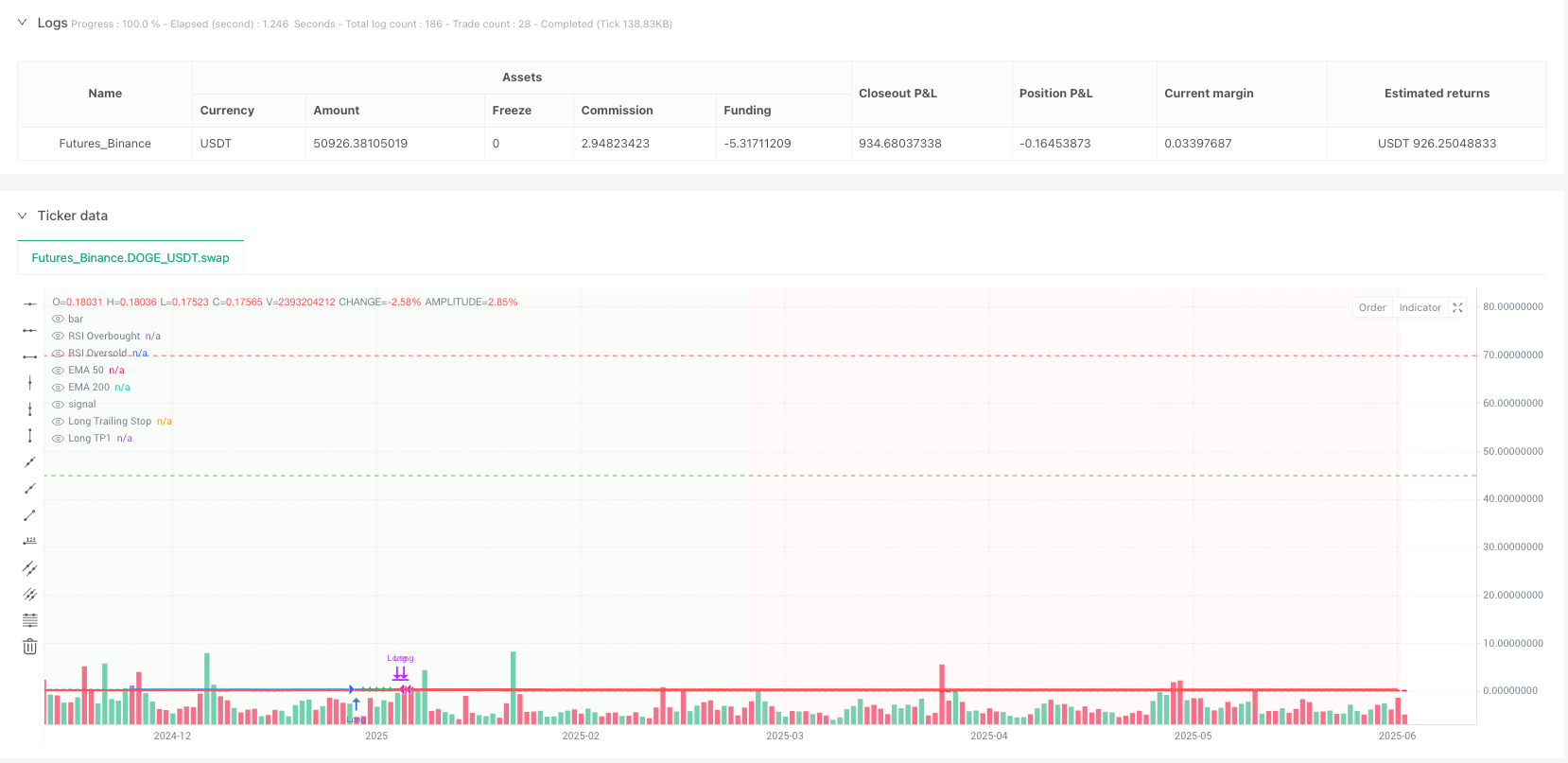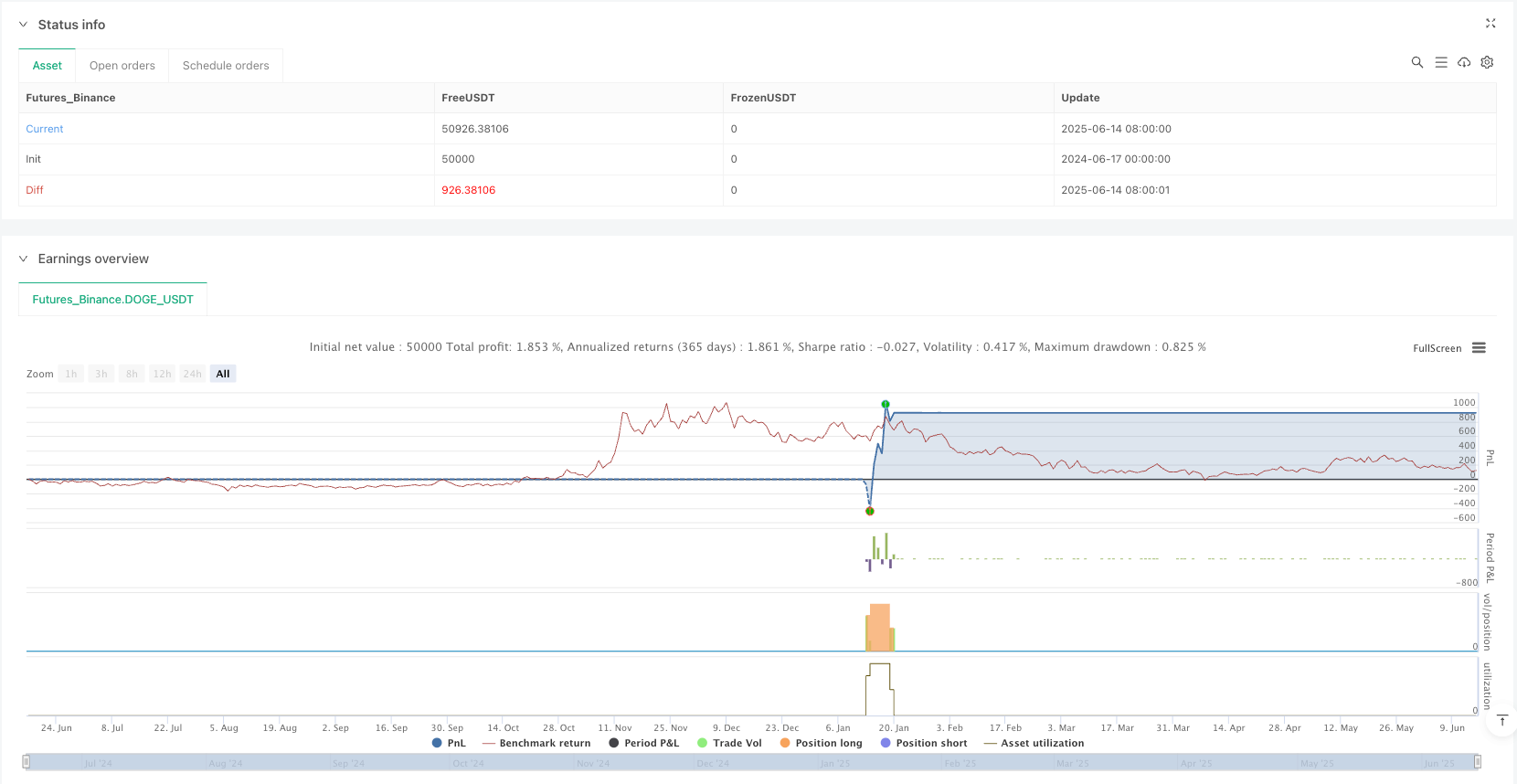

概述
本策略是一种综合性的趋势追踪与动量协同交易系统,主要基于均线趋势判断与相对强弱指数(RSI)动量确认来识别高概率交易机会。策略核心遵循”顺势而为”的交易哲学,仅在确认市场主趋势方向后,等待回调并结合动量指标寻找最佳入场点。同时,策略采用基于真实波动幅度(ATR)的风险管理系统,确保每笔交易风险一致性,并通过分段获利与尾随止损机制优化资金管理效率。
策略原理
策略运作原理基于四个关键模块:趋势识别、入场条件判断、风险管理与获利优化。
趋势识别:
- 使用50日和200日指数移动平均线(EMA)确定市场趋势方向
- 当50日EMA > 200日EMA时,识别为上升趋势,仅允许做多
- 当50日EMA < 200日EMA时,识别为下降趋势,仅允许做空
入场条件判断:
- 趋势确认后,等待价格回调至50日EMA附近(距离不超过ATR的预设倍数)
- 在上升趋势中,等待RSI跌至超卖区域(默认45以下)再反弹突破,作为做多信号
- 在下降趋势中,等待RSI涨至超买区域(默认70以上)再回落突破,作为做空信号
风险管理:
- 基于ATR设置动态止损,根据市场波动性自适应调整止损距离
- 每笔交易风险固定为账户资金的1%(可调整),通过精确计算仓位大小实现
- 止损位置设定为入场价格加减(ATR × 1.5),确保止损不会因随机波动被触发
获利优化:
- 采用分段获利策略:当达到2.1:1的风险回报比时,平仓50%头寸锁定利润
- 剩余50%头寸使用基于ATR的尾随止损,让盈利继续扩大
- 当趋势反转(均线关系改变)时强制平仓,避免趋势终结带来的大幅回撤
策略实现中,使用精确的数学计算确定最佳仓位大小,确保每笔交易风险控制在预设水平,同时允许通过参数调整适应不同市场条件。
策略优势
该策略具有以下显著优势:
高质量交易信号:通过趋势与动量协同确认,只在高概率方向上开仓,显著提高胜率。代码中
long_trend_ok与long_rsi_recovery等条件组合,确保交易信号质量。自适应风险管理:基于ATR的止损设计使策略能够根据市场波动性自动调整风险参数。在波动剧烈的市场环境下使用更宽松的止损,而在平静市场中使用更紧密的止损,实现最优风险控制。
资金管理最优化:分段获利机制(50%头寸在2.1R处获利,剩余部分采用尾随止损)实现了既能确保获利又能最大化捕捉趋势的平衡。代码中的
long_tp1_hit和long_trail_stop等变量精确控制这一过程。规则客观明确:策略完全量化,消除交易中的情绪干扰,执行纪律性强。所有交易决策基于明确的数学计算和逻辑条件,避免了主观判断。
可视化辅助决策:策略提供了完善的视觉反馈系统,包括趋势背景着色、入场信号标记和止损/获利目标可视化,便于交易者理解和监控策略运行。
参数可调适性:核心参数如EMA周期、RSI阈值、ATR倍数等均可调整,使策略能够适应不同市场环境和个人风险偏好。
策略风险
尽管该策略具有多重优势,但仍存在以下潜在风险:
趋势识别滞后性:使用EMA作为趋势判断工具存在固有滞后性,可能在趋势初期错过部分机会或在趋势结束时仍保持原方向仓位。解决方案是考虑增加短期趋势确认指标或调整EMA参数提高敏感度。
假突破风险:RSI反转信号可能出现假突破,导致错误交易。针对此风险,可以增加确认条件如成交量变化或其他动量指标协同确认。
不适合横盘市场:策略在明显趋势市场表现最佳,而在横盘整理阶段可能产生频繁的错误信号和亏损交易。建议在市场处于明显区间震荡时暂停策略,可通过增加趋势强度过滤器来识别此类情况。
参数敏感性:策略性能对参数选择较为敏感,特别是EMA周期和RSI阈值的设定。建议通过历史回测在不同市场条件下优化参数,避免过度拟合。
资金管理风险:固定百分比风险管理在极端市场条件下仍可能导致连续亏损累积。建议考虑实施动态风险调整机制,在连续亏损后逐步减小仓位大小。
优化方向
根据策略代码分析,以下是可能的优化方向:
多时间周期协同确认:整合多个时间周期的趋势和动量信号,提高交易决策的准确性。例如,可以检查日线趋势与4小时动量是否一致,只在方向一致时交易。
增加趋势强度过滤:引入ADX(平均方向指数)等趋势强度指标,只在趋势足够强时开仓,避免弱趋势或横盘市场的错误信号。代码可在
uptrend和downtrend条件中增加强度判断。动态调整风险参数:基于市场波动率、账户权益曲线或策略绩效指标动态调整每笔交易风险比例,在策略表现良好时适度增加风险,表现不佳时降低风险。
整合市场环境分析:引入宏观市场环境识别模块,如波动率指数或市场结构分析,根据不同市场阶段自动调整策略参数或选择性启用。
优化止盈机制:当前策略使用固定的2.1R作为第一止盈点,可考虑基于支撑阻力或波动率动态调整止盈位置,在关键价格水平附近获利。
增加交易时机过滤:考虑时间过滤器或成交量条件,避开低流动性时段或异常成交量状况,提高信号质量。
机器学习优化:利用机器学习算法动态预测最优参数组合或交易权重,根据实时市场条件自适应调整。
总结
趋势动量协同加权风险管理量化交易策略是一个集趋势识别、动量确认、精准风险控制和智能资金管理于一体的完整交易系统。通过EMA均线确定市场大方向,RSI动量指标确认最佳入场时机,同时采用基于ATR的动态止损和分段获利机制,实现风险和收益的最优平衡。
该策略最大的优势在于其系统性和纪律性,通过明确的量化规则消除交易过程中的情绪干扰,适合追求稳健交易风格的量化交易者。同时,策略的风险管理模块确保了单笔亏损有限而盈利潜力无限,符合成功交易的核心原则。
尽管存在一些固有的局限性,如趋势判断滞后和横盘市场适应性不足,但通过前文提出的优化方向,如多时间周期分析、趋势强度过滤和动态风险调整等,可以进一步提升策略的鲁棒性和适应性。未来发展方向应着重于增强策略的自适应能力,使其能够在不同市场环境下保持稳定表现。
对于追求系统化交易方法的投资者而言,本策略提供了一个坚实的基础框架,可根据个人风险偏好和市场理解进行进一步定制和优化。
/*backtest
start: 2024-06-17 00:00:00
end: 2025-06-15 08:00:00
period: 1d
basePeriod: 1d
exchanges: [{"eid":"Futures_Binance","currency":"DOGE_USDT"}]
*/
//@version=5
strategy("Crypto Swing Trading Strategy (1-5 Day)", overlay=true, default_qty_type=strategy.percent_of_equity, default_qty_value=100, pyramiding=0, calc_on_every_tick=false, calc_on_order_fills=false)
// ============================================================================
// STRATEGY INPUTS
// ============================================================================
// Trend Filter Settings
ema_fast_length = input.int(50, title="Fast EMA Length", minval=1, group="Trend Filter")
ema_slow_length = input.int(200, title="Slow EMA Length", minval=1, group="Trend Filter")
// RSI Settings
rsi_length = input.int(14, title="RSI Length", minval=1, group="Momentum")
rsi_oversold = input.int(45, title="RSI Oversold Level", minval=1, maxval=50, group="Momentum")
rsi_overbought = input.int(70, title="RSI Overbought Level", minval=50, maxval=99, group="Momentum")
// ATR Settings
atr_length = input.int(14, title="ATR Length", minval=1, group="Risk Management")
atr_stop_mult = input.float(1.5, title="ATR Stop Loss Multiplier", minval=0.1, step=0.1, group="Risk Management")
atr_trail_mult = input.float(1.0, title="ATR Trailing Stop Multiplier", minval=0.1, step=0.1, group="Risk Management")
// Risk Management
risk_per_trade = input.float(1.0, title="Risk Per Trade (%)", minval=0.1, maxval=5.0, step=0.1, group="Risk Management")
reward_ratio = input.float(2.1, title="Initial Take Profit Ratio (R:R)", minval=1.0, step=0.1, group="Risk Management")
// Strategy Settings
pullback_distance = input.float(1.0, title="Max Distance from 50 EMA for Pullback (ATR)", minval=0.1, step=0.1, group="Entry Conditions")
enable_shorts = input.bool(true, title="Enable Short Trades", group="Strategy Settings")
enable_longs = input.bool(true, title="Enable Long Trades", group="Strategy Settings")
// ============================================================================
// INDICATOR CALCULATIONS
// ============================================================================
// Moving Averages
ema_fast = ta.ema(close, ema_fast_length)
ema_slow = ta.ema(close, ema_slow_length)
// RSI
rsi = ta.rsi(close, rsi_length)
// ATR
atr = ta.atr(atr_length)
// ============================================================================
// TREND IDENTIFICATION
// ============================================================================
// Primary trend based on EMA relationship
uptrend = ema_fast > ema_slow
downtrend = ema_fast < ema_slow
// ============================================================================
// ENTRY CONDITIONS
// ============================================================================
// Long Entry Conditions
long_trend_ok = uptrend and enable_longs
long_pullback = math.abs(close - ema_fast) <= (pullback_distance * atr) and close < ema_fast[1]
long_rsi_oversold = rsi[1] < rsi_oversold
long_rsi_recovery = rsi > rsi_oversold and rsi[1] <= rsi_oversold
long_entry_condition = long_trend_ok and long_pullback and long_rsi_oversold and long_rsi_recovery
// Short Entry Conditions
short_trend_ok = downtrend and enable_shorts
short_pullback = math.abs(close - ema_fast) <= (pullback_distance * atr) and close > ema_fast[1]
short_rsi_overbought = rsi[1] > rsi_overbought
short_rsi_decline = rsi < rsi_overbought and rsi[1] >= rsi_overbought
short_entry_condition = short_trend_ok and short_pullback and short_rsi_overbought and short_rsi_decline
// ============================================================================
// POSITION SIZING
// ============================================================================
// Calculate position size based on risk per trade and ATR stop distance
calculate_position_size(entry_price, stop_price, risk_percent) =>
risk_amount = strategy.equity * (risk_percent / 100)
stop_distance = math.abs(entry_price - stop_price)
position_size = stop_distance > 0 ? risk_amount / stop_distance : 0
position_size
// ============================================================================
// STRATEGY VARIABLES
// ============================================================================
var float long_entry_price = na
var float long_stop_price = na
var float long_tp1_price = na
var float long_trail_stop = na
var bool long_tp1_hit = false
var float short_entry_price = na
var float short_stop_price = na
var float short_tp1_price = na
var float short_trail_stop = na
var bool short_tp1_hit = false
// ============================================================================
// LONG TRADE MANAGEMENT
// ============================================================================
// Long Entry
if long_entry_condition and strategy.position_size == 0
long_entry_price := close
long_stop_price := close - (atr_stop_mult * atr)
long_tp1_price := close + (reward_ratio * (close - long_stop_price))
long_trail_stop := long_stop_price
long_tp1_hit := false
// Calculate position size
pos_size = calculate_position_size(long_entry_price, long_stop_price, risk_per_trade)
strategy.entry("Long", strategy.long, qty=pos_size)
strategy.exit("Long Stop", "Long", stop=long_stop_price)
// Long TP1 Management (Take 50% profit at 2:1 R:R)
if strategy.position_size > 0 and not long_tp1_hit and high >= long_tp1_price
long_tp1_hit := true
strategy.close("Long", qty_percent=50, comment="TP1 - 50%")
// Move stop to breakeven
long_trail_stop := long_entry_price
strategy.cancel("Long Stop")
// Long Trailing Stop (for remaining 50% position)
if strategy.position_size > 0 and long_tp1_hit
// Calculate new trailing stop
highest_since_tp1 = ta.highest(high, 1)
new_trail_stop = highest_since_tp1 - (atr_trail_mult * atr)
// Only move stop up, never down
if new_trail_stop > long_trail_stop
long_trail_stop := new_trail_stop
// Exit on trailing stop or trend reversal
if close <= long_trail_stop or not uptrend
strategy.close("Long", comment=not uptrend ? "Trend Reversal" : "Trailing Stop")
// ============================================================================
// SHORT TRADE MANAGEMENT
// ============================================================================
// Short Entry
if short_entry_condition and strategy.position_size == 0
short_entry_price := close
short_stop_price := close + (atr_stop_mult * atr)
short_tp1_price := close - (reward_ratio * (short_stop_price - close))
short_trail_stop := short_stop_price
short_tp1_hit := false
// Calculate position size
pos_size = calculate_position_size(short_entry_price, short_stop_price, risk_per_trade)
strategy.entry("Short", strategy.short, qty=pos_size)
strategy.exit("Short Stop", "Short", stop=short_stop_price)
// Short TP1 Management (Take 50% profit at 2:1 R:R)
if strategy.position_size < 0 and not short_tp1_hit and low <= short_tp1_price
short_tp1_hit := true
strategy.close("Short", qty_percent=50, comment="TP1 - 50%")
// Move stop to breakeven
short_trail_stop := short_entry_price
strategy.cancel("Short Stop")
// Short Trailing Stop (for remaining 50% position)
if strategy.position_size < 0 and short_tp1_hit
// Calculate new trailing stop
lowest_since_tp1 = ta.lowest(low, 1)
new_trail_stop = lowest_since_tp1 + (atr_trail_mult * atr)
// Only move stop down, never up
if new_trail_stop < short_trail_stop
short_trail_stop := new_trail_stop
// Exit on trailing stop or trend reversal
if close >= short_trail_stop or not downtrend
strategy.close("Short", comment=not downtrend ? "Trend Reversal" : "Trailing Stop")
// ============================================================================
// PLOTTING
// ============================================================================
// Plot EMAs
plot(ema_fast, title="EMA 50", color=color.blue, linewidth=2)
plot(ema_slow, title="EMA 200", color=color.red, linewidth=2)
// Color background based on trend
bgcolor(uptrend ? color.new(color.green, 95) : downtrend ? color.new(color.red, 95) : na, title="Trend Background")
// Plot RSI levels (scaled to price for visualization)
hline(rsi_overbought, title="RSI Overbought", color=color.red, linestyle=hline.style_dashed)
hline(rsi_oversold, title="RSI Oversold", color=color.green, linestyle=hline.style_dashed)
// Plot entry signals
plotshape(long_entry_condition, title="Long Entry", style=shape.triangleup, location=location.belowbar, color=color.green, size=size.normal)
plotshape(short_entry_condition, title="Short Entry", style=shape.triangledown, location=location.abovebar, color=color.red, size=size.normal)
// Plot stop losses and targets for current position
plot(strategy.position_size > 0 ? long_trail_stop : na, title="Long Trailing Stop", color=color.red, style=plot.style_stepline, linewidth=2)
plot(strategy.position_size < 0 ? short_trail_stop : na, title="Short Trailing Stop", color=color.red, style=plot.style_stepline, linewidth=2)
plot(strategy.position_size > 0 and not long_tp1_hit ? long_tp1_price : na, title="Long TP1", color=color.green, style=plot.style_cross, linewidth=2)
plot(strategy.position_size < 0 and not short_tp1_hit ? short_tp1_price : na, title="Short TP1", color=color.green, style=plot.style_cross, linewidth=2)
// ============================================================================
// INFORMATION DISPLAY (Using Labels instead of Table)
// ============================================================================
// Display key information using labels on the last bar
if barstate.islast
// Create info label with key metrics
trend_text = uptrend ? "UP" : downtrend ? "DOWN" : "SIDE"
position_text = strategy.position_size > 0 ? "LONG" : strategy.position_size < 0 ? "SHORT" : "NONE"
info_text = "Trend: " + trend_text + "\nRSI: " + str.tostring(math.round(rsi, 1)) + "\nATR: " + str.tostring(math.round(atr, 2)) + "\nPosition: " + position_text
label.new(bar_index, high + atr, info_text,
color=uptrend ? color.new(color.green, 80) : downtrend ? color.new(color.red, 80) : color.new(color.gray, 80),
textcolor=color.white, style=label.style_label_down, size=size.normal)
// ============================================================================
// ALERTS
// ============================================================================
// Alert conditions
alertcondition(long_entry_condition, title="Long Entry Signal", message="LONG: Swing trading signal for {{ticker}} at {{close}}")
alertcondition(short_entry_condition, title="Short Entry Signal", message="SHORT: Swing trading signal for {{ticker}} at {{close}}")
alertcondition(strategy.position_size > 0 and long_tp1_hit, title="Long TP1 Hit", message="LONG TP1: First target hit for {{ticker}} at {{close}}")
alertcondition(strategy.position_size < 0 and short_tp1_hit, title="Short TP1 Hit", message="SHORT TP1: First target hit for {{ticker}} at {{close}}")
// ============================================================================
// STRATEGY SUMMARY
// ============================================================================
// This strategy implements the full swing trading approach described in the document:
// 1. Trend filtering using 50/200 EMA (only trade with the trend)
// 2. RSI momentum for entry timing (buy oversold in uptrend, sell overbought in downtrend)
// 3. ATR-based position sizing and stop losses (volatility-adjusted risk management)
// 4. Partial profit taking at 2:1 R:R (50% of position)
// 5. Trailing stops for remaining position using ATR
// 6. Trend reversal exits (close all when trend changes)
//
// Key Features:
// - Configurable parameters for different market conditions
// - Risk management with consistent 1% risk per trade
// - Visual indicators for trend, signals, and trade management
// - Information table showing key metrics
// - Alert system for automated notifications
//
// Recommended for: BTC, ETH, XRP on daily timeframes
// Holding period: 1-5 days typical